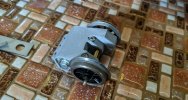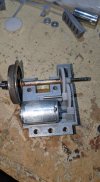Greg Elmassian
Guest
Synchronizing separate motors through siderods could be an issue, more force on the siderods, could cause binding.
could this method theorectily be used to make a motorblock for a 2-8-2 or 2-8-8-0 locomotive?


When you have developed this to the point that you are happy with the performance, are you considering selling the part or posting the 3D file? I have an old Bachmann trolley that needs a new drive train.Sorry for the late reply. Theoretically it could be adapted to pretty much any rollingstock, though the specifics of which axle and wheel diameters you use would affect the design. I suspect that for a large heavy duty locomotive like a 2-8-2 you'd be better of using a single large motor and worm gear reduction rather than a lot of small ones, especially if you have less of a space limitation because of wheel diameter or the need to fit them into bogies.
The original units fitted to the Ballarat tram in 2016 are still in service and have covered many real kilometres since. In the endless quest to make these cheap and quick to assemble though I have since developed a 3D printed gearbox case with a double reduction.
View attachment 294965
View attachment 294966
This version uses a smaller motor and gear diameter making it suitable for slightly smaller 28mm wheels. So far the test installation has been promising.
I think so, with this method.could this method theorectily be used to make a motorblock for a 2-8-2 or 2-8-8-0 locomotive?
When you have developed this to the point that you are happy with the performance, are you considering selling the part or posting the 3D file? I have an old Bachmann trolley that needs a new drive train.
